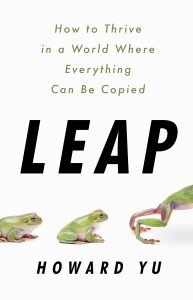Leaping to a New Growth Curve – Part 1 of 3

Recently I had the opportunity to interview Howard Yu, LEGO professor of management and innovation at the prestigious IMD Business School in Switzerland, director of IMD’s signature Advanced Management Program (AMP), and author of the book Leap: How to Thrive in a World Where Everything Can Be Copied to investigate a series of important questions about what we can learn from our history while looking to create our future. Without further ado, here is the transcript of that interview (Part 1 of 3):
1. When facing an onslaught of new competition, what helps some pioneering businesses escape relatively unscathed while latecomers sweep others away?
When industry knowledge becomes stagnant, incumbents become vulnerable to assaults from new entrants. The defining characteristic of pioneering companies that stay ahead of their competitors is that they leap: they jump across knowledge disciplines to leverage and create new knowledge about how a product is made or a service is delivered. The best companies leap repeatedly. Absent such efforts, latecomers will catch up. Understanding this phenomenon is the first step toward long-term success.
 2. In a global economy in which access to information, technology, and cheap labor is almost instant, has first-mover advantage become obsolete?
2. In a global economy in which access to information, technology, and cheap labor is almost instant, has first-mover advantage become obsolete?
That’s true for some industries more than others. Take the personal computer, for instance. Consider for a moment the engineering marvel of the hard disk drive (HDD). Unlike conventional tape storage, HDD stores and retrieves blocks of data, not sequentially, as was the case with cassette tapes, but in a faster, random-access manner. A hard drive comprises rotating disks that spin some seven thousand times per minute, while a magnetic head moves to read and write data onto the disks. This is equivalent to a pilot’s flying a fighter jet at over 600 miles per hour at an altitude of around 9,850 feet and dropping tennis balls into buckets six hundred times without making a single mistake.
Such is the kind of engineering marvel that only IBM’s San Jose laboratories could create in the mid-1950s. The first workable model was launched in 1956. Since then, HDD technology has substantially improved—the physical size of the hard drive has been reduced even as storage capacity multiplied. But the center of innovation slipped elsewhere. Competitors sprawl across the globe today. Toshiba in Japan, followed by several Taiwanese companies, has come to compete aggressively in the sector with brutally efficient manufacturing processes. So fierce has been the pricing pressure that the industry has been driven to a zero-profit-margin subsistence.
Even in nascent industries such as renewable energy, pioneers such as General Electric, Siemens, Philips, and Vestas have seen the encroachment of China’s Goldwind and Sinovel, who have snatched market share away and so become formidable competitors. This happens so commonly across industries that many consider it as inevitable as Darwinian evolution. All this suggests that the idea of a sustainable advantage is illusory.
Market competition can be compared to mountaineering, in which rival companies seek to reach the peak. In industries like piano-making where the knowledge base changes slowly, or doesn’t change at all, newcomers will eventually reach the same altitude as the incumbents. In such scenarios, first-mover advantage is fleeting at best.
But in industries in which the knowledge base keeps evolving, like pharmaceuticals, new discoveries are analogous to constant mudslides. No one reaches the mountaintop; everyone is constantly being pushed downward. In such a race, experience and prior knowledge matter; fortune favors the prepared. Because of their deep industry know-how, pioneering companies stand a better chance of successfully leaping.
 3. Could you explain how a knowledge leap works and why such leaps are crucial to staying competitive?
3. Could you explain how a knowledge leap works and why such leaps are crucial to staying competitive?
Let’s take a look at big pharma. The fact that executives view knowledge, capital, and expertise as temporary—and competitive advantage as hardly sustainable—is nothing new.
More than a century ago, German drug maker Hoechst made similar complaints against its Swiss copycats, CIBA, Giegy, and Sandoz. In the land of counterfeiters, or “le pays de contre-facteurs,†as the French would say, Switzerland had yet to pass patent laws in as late as 1888. Local chemists were free, even encouraged, to imitate foreign inventions. When antipyrine—the first synthetic fever-reducing drug—was developed in the laboratory, the world couldn’t get enough of it, and the Swiss sold a German imitation as soon as they were able to produce it. Organic chemistry was the hotbed of innovation.
Only when Alexander Fleming discovered penicillin did everyone understand that the next blockbuster would no longer come solely from chemistry but from an entirely new discipline: microbiology. Right after World War II, all over the world, from Europe to the U.S., nascent pharmaceutical firms hurriedly set up soil screening programs to look for exotic fungi and strike pay dirt, in search for ever more potent antibiotics. Fieldworkers collected soil from cemeteries and sent balloons up in the air to gather windblown samples. They went down to the bottoms of mine shafts, hiked to mountaintops, and ventured everywhere else in between. The study of microbes took center stage, displacing organic chemistry as the key discipline for scientific discovery.
Along with new techniques of deep-tank fermentation and medicine purification came a precipitous drop in infectious disease. What was once a nasty, brutish, and fatal infection became a curable inconvenience.
Then came the biotechnology revolution in the ’70s. Scientists marveled at the inner workings of chromosomes in the nuclei of cells and eventually learned to recombine DNA molecules, instruct bacteria to produce insulin for diabetics, and produce many other active ingredients that can’t be abundantly harvested from nature.
Later, with the complete scanning of the human genome and the advancements in computational applications, genetic engineering went digital. Scientists are now discovering molecular pathways and the biological underpinnings of even rare cancers. Once again, we witnessed the transition into a new knowledge frontier, a discipline under the rubric of genomics and bioengineering.
Today, it takes extravagantly equipped laboratories, huge budgets, and large teams of investigators to stay at the forefront of the industry. Switzerland’s Novartis in 2013 spent a staggering $10 billion on research and development. Western pioneers are still ahead in the latest developments in cancer therapy, HIV treatment, and many others. Unlike in the automotive industry, where global competition has decimated Detroit and turned it into the American rust belt, the wealth in Basel, where Novartis is headquartered, seems forever bountiful. The city’s inhabitants continue to enjoy the highest standards of living in Western Europe.
Still, capital expenditure in the pharmaceutical industry does not accurately explain how newcomers in emerging countries fail to overtake pioneering incumbents. In fact, capital expenditure, trade secrets, and patent protection were hardly a challenge for the U.S. when it overtook Great Britain as the leading exporter of textiles during the turn of the century. The same can be said about the industries of heavy machinery, wind turbines, solar panels, personal computers, mobile phones, and automobiles, where latecomers irrevocably displaced early pioneers.
The history of pharmaceuticals has shown it was the leaping across knowledge disciplines—chemistry, microbiology, and genomics—that opened new paths for willing pioneers to race ahead. Sustainable advantage comes not so much from a utopian position that a company could try to attain; rather, only by infusing new knowledge and constantly changing the rules of the game can a pioneer create headroom for innovation and thus prevent latecomers from catching up. That’s the miracle drug that kept the centuries-old pharmaceutical companies evergreen.
4. In LEAP, you illustrate your principles using historical narratives. What drew you to the 19th-century history of Southern textile mills? What are some of its parallels with other industries, and why can history teach 21st century business leaders about innovation and survival?
The experience of a Hong Konger, as unlikely as it may seem, is similar to that of a Southerner in the Piedmont. During the breakneck expansion in the late 19th century, major textile mills—Holt, Cannon, Gray, Springs, Love, Duke, and Hanes—swept through the South as the export industry took off. Together they ended the tight grip of British manufacturers on the Asian market since the Industrial Revolution. And by the 1930s, Southern spindles accounted for 75% of the total spindles in the U.S. Local news routinely attributed this stunning success to the salesmanship and ingenuity of the hardworking Southerners, who had pretty much put everyone else out of business.
Then the one-dollar blouse from Japan arrived shortly after World War II.
The Japanese seemed to possess the same knack for ingenuity and hardworking ethics. These foreigners produced textiles even more cheaply than the Southerners. But even so, over the course of the next decade, apparel production in Japan also went to Hong Kong, Taiwan, and South Korea. And when wages rose in those places, textile plants moved farther out to China, India, and Bangladesh in an epic race to the bottom. In 2000, textile workers in China and Indonesia were paid less than $1 an hour; in the U.S., workers earned around $14.
By the end of the 20th century, large, populous U.S. mill towns had all but dwindled to mere shadows of their former selves. Industrial buildings were boarded up and abandoned, painfully repurposed, or reopened as museums.
At the end of the day, the search for a unique position that guarantees sustainable advantage is an illusion. Intellectual property, market positioning, brand recognition, manufacturing scale, and even distribution networks can never withstand competition for long. No value proposition, despite its uniqueness, will remain unchallenged. Good designs and great ideas are copied regardless of patent laws and trade secrets. The only way to prosper over long periods under such conditions is to leap: Pioneers must jump across knowledge disciplines to leverage or create new knowledge on how a product is made or a service is delivered. Absent such efforts, latecomers will always catch up.
Final Words
LEAP began as a historical account, a memoir of Western pioneers. Some of these pioneers failed, some survived, others prospered. But it’s also a playbook for the future. More importantly, it’s a manifesto for how pioneering companies can rethink their businesses, their relationship with their customers, and the reasons they exist. Any organization — large or small — has a set of traditional strengths and important products that have helped build it into what it is today. There is no perfect moment to innovate. But everyone has exactly enough time, starting now.
Wait! Before you go…
Choose how you want the latest innovation content delivered to you:
- Daily — RSS Feed — Email — Twitter — Facebook — Linkedin Today
- Weekly — Email Newsletter — Free Magazine — Linkedin Group
 Braden Kelley is a popular innovation speaker, builds sustainable innovation cultures, and tools for creating successful change. He is the author of the five-star book Stoking Your Innovation Bonfire and the creator of a revolutionary new Change Planning Toolkit™. Follow him on Twitter (@innovate) and Linkedin.
Braden Kelley is a popular innovation speaker, builds sustainable innovation cultures, and tools for creating successful change. He is the author of the five-star book Stoking Your Innovation Bonfire and the creator of a revolutionary new Change Planning Toolkit™. Follow him on Twitter (@innovate) and Linkedin.
NEVER MISS ANOTHER NEWSLETTER!
LATEST BLOGS
Three things you didn’t know about credit cards
Photo by Ales Nesetril on Unsplash Many of us use credit cards regularly. From using them for everyday purchases to…
Read MoreFive CV skills of a business-minded individual
Photo by Scott Graham on Unsplash The skills listed on a CV help employers quickly understand your suitability for a…
Read More


